Supply Chain Risk Management (SCRM) Market Overview
The global supply chain risk management market size was valued at USD 2.9 billion in 2021, and is projected to reach USD 6.9 billion by 2031, growing at a CAGR of 9.2% from 2022 to 2031. The rise in demand for third-party risk management, as well as services & government initiatives in supply chain management and the adoption of cloud-based supply chain management solutions are the key drivers of supply chain risk management market growth. However, data security issues, as well as non-formal and manual risk management processes, are major factors limiting the growth of the SCRM market. Furthermore, the standardization of risk assessment processes across organizations, as well as the integration of advanced technologies is expected to provide growth opportunities for the market during the forecast period.
Key Market Trends
- Component: Services segment expected to witness significant growth.
- End-use Industry: Transportation and logistics segment projected to expand rapidly.
- Enterprise Size: Small and Medium Enterprises (SMEs) to show strong market growth.
- Deployment: Cloud deployment anticipated to dominate during the forecast period.
- Region: Asia-Pacific set to register the highest CAGR.
Market Size & Forecast
- 2031 Projected Market Size: USD 6.9 billion
- 2021 Market Size: USD 2.9 billion
- Compound Annual Growth Rate (CAGR) (2022-2031): 9.2%
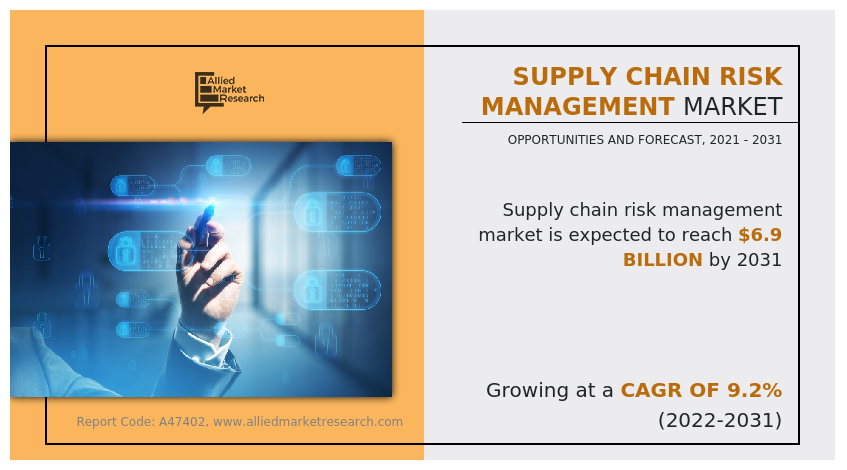
The process of identifying, assessing, and mitigating potential risks and uncertainties in a supply chain is known as supply chain risk management (SCRM). It entails identifying risk sources, assessing their impact, and taking proactive steps to prevent or mitigate their effects.
The goal of supply chain risk management (SCRM) is to ensure the continuity of supply chain operations and reduce the likelihood of disruptions such as product recalls, production delays, quality issues, and supply chain disruptions. The emphasis is on keeping goods and services flowing and protecting against supply chain-related losses. SCRM requires the participation of all supply chain stakeholders, including suppliers, manufacturers, distributors, and customers. It requires a comprehensive and proactive approach that includes risk assessments, contingency planning, risk mitigation strategies, and continuous monitoring & evaluation. Effective SCRM can improve supply chain resilience, boost brand reputation, and reduce the risk of financial loss.
Previously, it was assumed that only large businesses needed a well-thought-out, comprehensive SCRM plan. This was due to the high cost of implementing a viable SCRM plan. Identifying what to analyze, handling the complexity of data gathering, and gaining organizational buy-in, all required a significant investment of time, effort, and money.
Nevertheless, as the world & organizations become more integrated, and supply chains & regulations get more complex, SCRM is an operation that should be addressed by every firm. Organizations can now use AI and Machine Learning (ML)-enabled software solutions to help minimize the cost of building and deploying an SCRM plan. The use of technology has become increasingly important in SCRM, with the use of data analytics, artificial intelligence, & cloud-based systems to manage and monitor supply chain risk. Moreover, SCRM market growth is propelled by increased government regulations and standards. As Governments and industry groups are developing regulations and standards to improve supply chain transparency, accountability, and risk management.
Furthermore, collaboration and partnerships between major players is important for seamless supply of products and raw materials in industry. SCRM has become more collaborative, with companies partnering with their suppliers and other stakeholders to share information and work together to manage risk. For instance, in December 2022, SAP Ariba and PwC developed a new co-innovation strategy to assist organizations in meeting their ESG and net zero targets. It addressed supply chain risk management, monitoring, and compliance with this move.
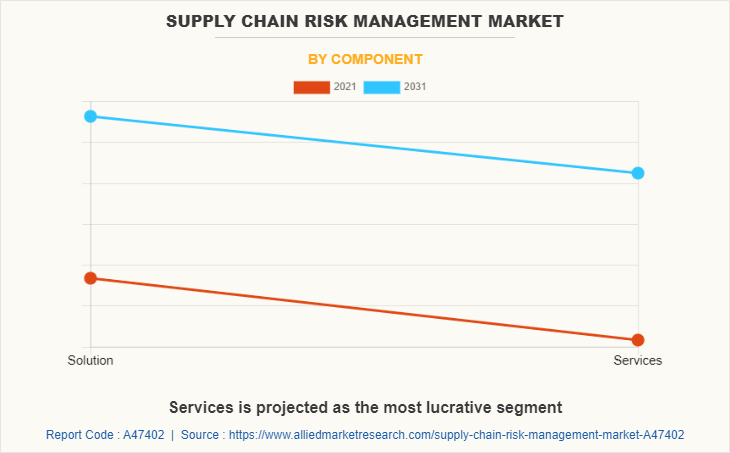
In 2021, Europe is second largest market for supply chain risk management software, which is part of supply chain management. As the retail sector is one of the most important sectors in the European Union economy, employing approximately one in every ten people in more than 3.6 million retail businesses, the demand for supply chain risk management is likely to rise in order to decrease both internal and external risks. The surge in focus on logistics value, a lot of which is driven by retail & home delivery, is likely to give numerous opportunities for market expansion in nations such as the UK. Furthermore, the market's expansion is due to a variety of causes, including an increase in North American vendor penetration in the Western market.
Market Segmentation
The supply chain risk management market is segmented on the basis of component, end-use industry, enterprise size, deployment, and region. By component, it is bifurcated into solution and services. By end use industry, it is classified into retail and consumer goods, healthcare and pharmaceuticals, manufacturing, food and beverages, transportation and logistics, automotive and other. By enterprise size, it is categorized into large enterprise and small & medium enterprise. By deployment, it is divided into on premise and cloud. By region, the market is analyzed across North America, Europe, Asia-Pacific, and LAMEA.
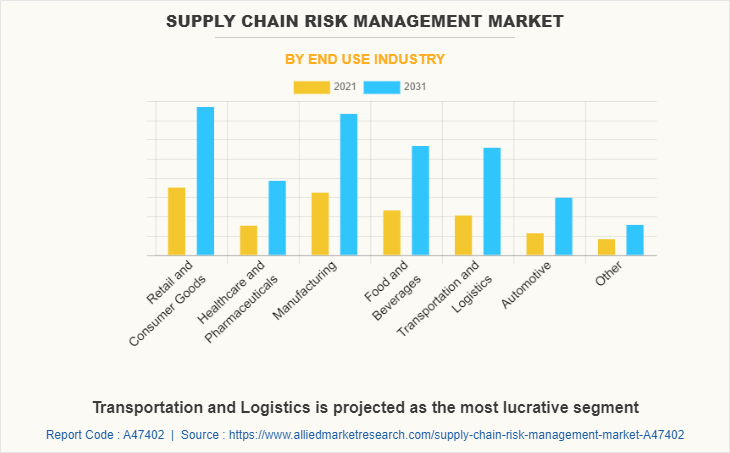
An increase in transportation and logistics spending is driving the adoption of automation technologies in logistics and supply chains. The transportation and logistics industry is large & competitive, and it includes distinct industries such as shipping, railroads, and air services. The adoption of SCM solutions in transportation management is expected to drive market expansion in this region owing to factors such as the digital revolution in the transportation sector, increased urbanization, and surge in traffic congestion.
Which are the Top Supply Chain Risk Management companies
The following are the leading companies in the market. These players have adopted various strategies to increase their market penetration and strengthen their position in the supply chain risk management industry.
- AnyLogistix
- Avetta LLC
- CURA
- DHL International GmbH
- EXIGER
- JAGGAER
- LogicManager, Inc.
- Marsh LLC
- MetricStream
- SAP Ariba
The leading companies have adopted strategies such as acquisition, partnership, product development, and product launch to strengthen their market position. In August 2022, EXIGER acquired Supply Dynamics in order to develop the first end-to-end supply chain visibility and risk management solution. It is the most advanced supply chain platform for tracking, tracing, and orchestrating the acquisition and supply of subcontracted products, parts, raw materials, and ingredients. In addition, in December 2021, LogicManager, Inc developed new ERM software that is compatible with modern risk management technology. It enhances innovative risk management software integrated with AI capabilities and adds new features to support a comprehensive ERM program.
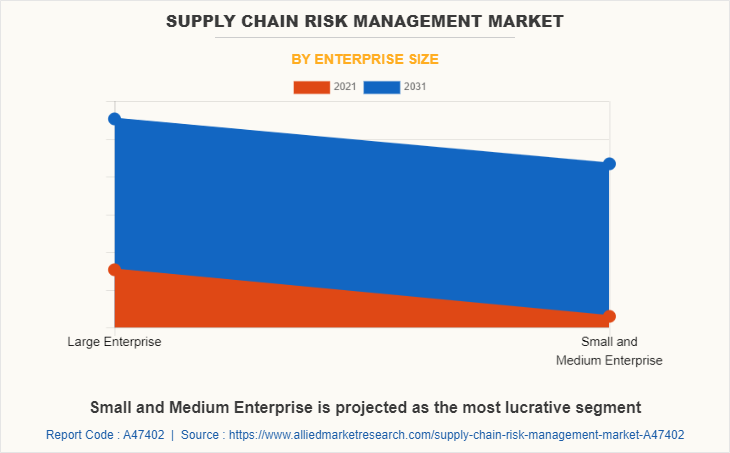
What are the Top Impacting Factors
Key Market Driver
Rise in adoption of cloud-based supply chain management solutions
Cloud-based supply chain management software has several advantages over on-premises supply chain management software. As it offers pay-per-usage licensing and requires less IT setup, businesses are turning to cloud supply chain management to transform their operations and save operational costs. Cloud SCM vendors are also updating their product offerings, which reduces system costs even further.
In addition, the market has a profitable potential as a result of factors including the expansion of cloud SCM in the e-commerce industry, the development in the adoption of cloud SCM among small & medium-sized organizations (SMEs), and the rise in demand for low initial investment. Moreover, it offers businesses a host of advantages such as quick deployment, reduced risk, higher flexibility, less stress on IT, increased visibility, and other advantages that are beneficial for market expansion.
Furthermore, organizations are using cloud-based solutions more frequently for supply chain management duties. As companies upgrade their supply chain strategies, cloud apps are anticipated to provide the flexibility to scale up quickly. As long as people continue to work remotely or in hybrid models, data is expected to be available whether at home, at work, or in the warehouse. For the business to succeed in the international market and the digital age, there needs to be more connectivity. Techniques and methods must evolve together with the supply chain. The possibility of loss is reduced, supply availability is increased, and stock levels are optimized with the use of software for supply chain risk optimization. This enhances the customer experience, boosts supply chain efficiency, and quickens market expansion.
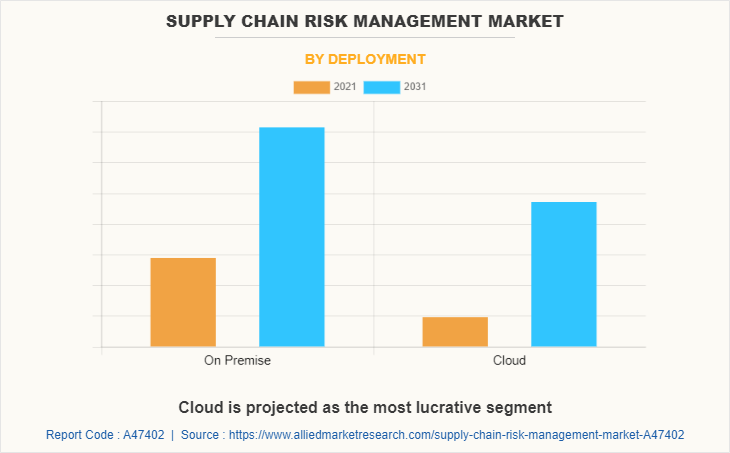
Increase in demand for third party risk management
Third-party risk is the potential financial loss incurred by a business that relies on outside parties to deliver services. Vendors, contractors, partners, suppliers, and non-human workers such as internet of things (IoT) devices, robotic process automation (RPA), bots, and service accounts are just a few of the various third-party communities that make up the supply chain. These third-party communities usually require access to intellectual property, confidential data, and product & software designs of a corporation.
In addition to the typical services such as the fabrication of parts or the assembly of goods for a company's customers, third-party risk might come from the shared data between businesses and such outside parties. Companies deal with outsiders or third parties more regularly, especially those who haven't been adequately vetted. Hence, there is a higher possibility of business disruption and data breaches. In addition, a 2019 Spiceworks survey found that, out of 600 firms, 44% had a data breach brought on by a third-party provider.
In addition, many organizations are relying more on vendors and partners to support critical business functions in order to keep up with the digital transition. Thus, these companies unintentionally, or at the very least unwillingly, increase their attack surface. These third-party identities could quickly transform from a competitive advantage to a weakness if a company does not have a solid third-party reputation and risk management strategy. The adoption of third-party risk management tools can reduce the risks associated with interacting with third parties. Moreover, by enabling management to plan for operational efficiency within known probable outcomes, third-party risk management places a heavy emphasis on reducing risks and their effects on performance.
Furthermore, businesses that take an active approach to third-party management can successfully lower their risk of data leaks and protect important product secrets from competitors or industries where intellectual property infringement is rampant. These factors boost the demand for third-party risk management solutions, which drives market growth.
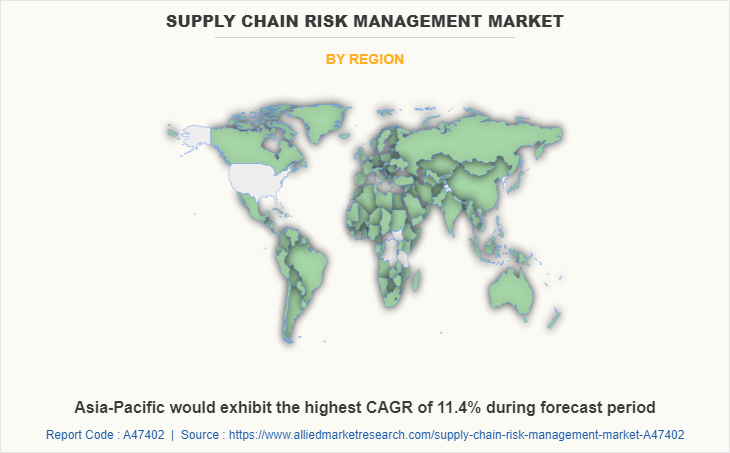
Key Benefits for Stakeholders
- This report provides a quantitative analysis of the market segments, current trends, estimations, and dynamics of the supply chain risk management market analysis from 2021 to 2031 to identify the prevailing supply chain risk management market opportunities.
- The market research is offered along with information related to key drivers, restraints, and opportunities.
- Porter's five forces analysis highlights the potency of buyers and suppliers to enable stakeholders make profit-oriented business decisions and strengthen their supplier-buyer network.
- In-depth analysis of the supply chain risk management market segmentation assists to determine the prevailing market opportunities.
- Major countries in each region are mapped according to their revenue contribution to the global market.
- Market player positioning facilitates benchmarking and provides a clear understanding of the present position of the market players.
- The report includes the analysis of the regional as well as global supply chain risk management market trends, key players, market segments, application areas, and market growth strategies.
Supply Chain Risk Management Market Report Highlights
| Aspects | Details |
| Market Size By 2031 | USD 6.9 billion |
| Growth Rate | CAGR of 9.2% |
| Forecast period | 2021 - 2031 |
| Report Pages | 279 |
| By Component |
|
| By End Use Industry |
|
| By Enterprise Size |
|
| By Deployment |
|
| By Region |
|
| Key Market Players | CURA, Avetta, LLC, SAP Arbia, MetricSream, Marsh LLC, JAGGAER, DHL International GmbH, EXIGER, AnyLogistix, LogicManager, Inc. |
Analyst Review
Supply chain risk management market is expected to grow rapidly in the coming years. The growth in globalization of supply chains, as well as the increase in frequency of disruptions, such as natural disasters, geopolitical instability, and health crises such as COVID-19, have propelled the demand for supply chain risk management solutions.
Companies want to better understand their risk exposure and implement risk-mitigation measures, which is driving increased investment in supply chain risk management technologies and solutions. This has fueled market growth, with an increasing number of businesses implementing solutions such as artificial intelligence, the Internet of Things, and cloud computing to help them better manage their supply chains and reduce risk. The pandemic has raised awareness of the importance of increased supply chain resilience and flexibility, as well as having contingency plans in place to respond to disruptions. As a result, many businesses are focusing risk management and taking a more proactive approach to supply chain risk management.
, The market for supply chain risk management is expected to keep expanding, with opportunities such as the standardization of the risk management process offering guidance on how to properly execute the risk management process as well as details on the procedure that should be employed. The goal of standardization is to increase efficiency by formalizing the risk management process. After making the decision, an organization must consider a few practical issues in order to properly implement risk management standards. These include creating a more specific organizational structure for risk management, developing a plan for risk management implementation, integrating risk management into the organization's culture, identifying all organizational risks, and developing a set of standards & metrics to measure risk management effectiveness. These features are expected to boost market growth during the forecast period by increasing standardization of risk assessment processes across organizations.
The global supply chain risk management market was valued at $2,910.8 million in 2021, and is projected to reach $6,932.8 million by 2031, registering a CAGR of 9.2% from 2022 to 2031.
Some leading companies profiled in the supply chain risk management market report comprises AnyLogistix, Avetta LLC, CURA, DHL International GmbH, EXIGER, JAGGAER, LogicManager, Inc., Marsh LLC, MetricSream, and SAP Arbia. The leading companies have adopted strategies such as acquisition, partnership, product development, and product launch to strengthen their market position.
Retail and consumer goods is the leading application of supply chain risk management market
North America is the largest regional market for supply chain risk management
Integration of advanced technologies and rise in adoption of cloud-based supply chain management solutions are the upcoming trends of supply chain risk management market
Loading Table Of Content...



